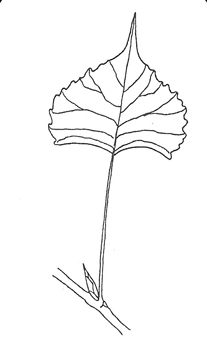Populus deltoides ssp. monilifera
Family: Salicaceae, Willow
Key Steps
- 1b – Alternate leaf arrangement — go to 18
- 18a – Leaf simple — go to 19
- 19b – Thornless — go to 22
- 22e – All leaves unlobed — go to 31
- 31a – Leaf is triangular or diamond/wedge-shaped — go to 32
- 32b – Petiole is flat — go to 34
- 34b – Form of tree is tall, wide, open — Plains Cottonwood
- 32b – Petiole is flat — go to 34
- 31a – Leaf is triangular or diamond/wedge-shaped — go to 32
- 22e – All leaves unlobed — go to 31
- 19b – Thornless — go to 22
- 18a – Leaf simple — go to 19
Description
 Leaf: Triangular, glossy. with flat base, pointed tip. May have 2 or 3 glands near base of leaf at top of flat petiole which is 2 1/2 to 4 inches long. Margins have large rounded to pointed teeth. 3-5 veins meet at leaf base.
Leaf: Triangular, glossy. with flat base, pointed tip. May have 2 or 3 glands near base of leaf at top of flat petiole which is 2 1/2 to 4 inches long. Margins have large rounded to pointed teeth. 3-5 veins meet at leaf base.
Bud: Lateral buds: lowermost bud scale is centered directly over the leaf scar (typical of all species of Poplar). Buds are larger (over 1/2 inch), pointed, shiny, and can be green, yellow or gray. Stick out away from stem. May be gummy. Terminal bud present.
Leaf Scar: Crescent-shaped, 3-6 bundle scars. Very noticeable stipule scars (horizontal lines) on either side of the leaf scar.
Stem: Knobby (due to the enlarged nodes) and grayish-green.
Bark: Gray, thick ridges and deep furrows.
Pith: Brown, solid, 5-sided.
Flower: Male and female flowers on separate trees. Flowers appear before leaves. Drooping catkins.
Fruit: Capsules split open to release small seeds that are on a mat of long silky hairs (cotton). Note: P. deltoides ‘Siouxland’ is cottonless.
Habit: Large, open form. Several main branches. Colorado native to the plains and foothills.
Culture: High water needs.
Resources




